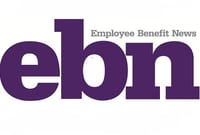
The Setting Every Community Up for Retirement Enhancement (SECURE) Act of 2019, passed by the House of Representatives on May 23, has the potential to make a positive impact on Americans’ retirement readiness. One of the bill’s key provisions involves removing restrictions on open multiple employer plans (MEPs), which would make it less costly for small businesses to offer retirement savings plans to employees.
The goal of the bill’s sponsors to enable more workers to participate in the U.S. retirement system is commendable. However, as it currently stands, the SECURE Act doesn’t include any measures to address the significant asset leakage experienced by our nation’s defined contribution plans every year.
The Employee Benefit Research Institute (EBRI) estimates that the amount of savings depleted from the U.S. retirement system through premature 401(k) account cash-outs totals $92.4 billion annually, based on 2015 cash-out data.
Without provisions to help workers participating in open MEPs avoid the destructive decision to cash out their savings, the SECURE Act is less likely to achieve the stated goals of its supporters.
Similarly, the Automatic Retirement Plan Act of 2017 (ARPA), which also proposed easing barriers to establishing open MEPs, did not put forward potential solutions for reducing cash-out leakage—a pervasive deterrent to filling the U.S. retirement savings shortfall.
The problem of cash-outs is exacerbated by the highly mobile nature of today’s workforce. According to EBRI and the U.S. Department of Labor, about 22.3% of our country’s 66.2 million active, contributing plan participants switch jobs on an annual basis—and research from the largest plan record-keepers indicates that 31.5% of these 14.8 million participants, a percentage which translates to 4.7 million people, cash out their 401(k) savings accounts within a year of leaving a job and terminating their participation in that former employer’s retirement plan.
Auto Portability is the Missing Ingredient
EBRI’s Retirement Security Projection Model® (RSPM®) estimates that the total retirement savings shortfall (defined as the amount of additional savings workers would need to offset their likely expenses in retirement) for U.S. households headed by those between ages 35 and 64 is a whopping $3.83 trillion, based on its latest analysis in March 2019.
Assuming no opt-outs occurred, EBRI analysis indicated that the ratification of ARPA and implementation of its provisions would reduce this retirement savings shortfall by $645 billion, or 15.6%. However, EBRI found that in the event auto portability was widely adopted within the U.S. retirement system simultaneously with ARPA provisions, the retirement savings shortfall would likely experience an additional $287 billion reduction—leading to a total decrease of $932 billion, or 22.6%.
Additional EBRI analysis, published earlier this month, found that auto portability would also enhance auto-IRAs’ capability to reduce the retirement savings shortfall. Auto-IRAs, another proposed solution to expand retirement plan eligibility for employers, would, under a set of optimistic assumptions, decrease the nation’s retirement savings shortfall among savers between 35 and 39 years old by 17.3%. But, when EBRI analyzed a scenario that included full adoption of auto portability alongside auto-IRAs, the retirement-savings deficit decreased by 27.1%!
Auto portability is the routine, standardized, and automated movement of a retirement plan participant’s small 401(k) savings account (less than $5,000) from their former employer’s plan to an active account in their current employer’s plan. If auto portability is broadly adopted and enabled by defined contribution plan sponsors and record-keepers, EBRI predicts that up to $1.5 trillion would be preserved in the U.S. retirement system, as measured in today’s dollars.
By taking a multi-pronged approach to simplifying plan-to-plan savings portability for participants and sponsors alike, the auto portability solution utilizes the proven advantages of creating new default options to change participant behavior and reduce cash-outs.
Unfortunately, the complexity and costliness of DIY plan-to-plan asset portability, combined with lack of assistance and guidance, historically made cashing out 401(k) accounts at the point of (or after) job-change the easiest option for participants. In fact, a 2015 study of mobile workforce behaviors, authored by Boston Research Technologies CEO Warren Cormier, found that only 37% of cash-outs are undertaken as a result of financial hardship.
But, when plan sponsors utilize auto portability, far fewer participants cash out. A Boston Research Group case study focusing on a large sponsor in the healthcare services sector reported that, following the implementation of auto portability, the company’s 401(k) plan reduced cash-outs by about 50% across all account balances. The participant default option changes from cashing out, or leaving balances behind, to consolidation by moving balances forward.
As it happens, the auto portability technology solution, powered by twin “locate” and “match” algorithms, went live two years ago this month.
Just as auto enrollment couldn’t truly fulfill its purpose without a complementary process for helping automatically enrolled participants transfer their 401(k) savings upon changing jobs, open MEPs won’t realize their full potential if participants find 401(k) balance consolidation too difficult or stressful.
Congressional sponsors and supporters of the SECURE Act and similar pieces of legislation can strengthen these bills by incorporating measures to encourage the nationwide adoption of auto portability, as an essential component of corporate financial wellness programs.
